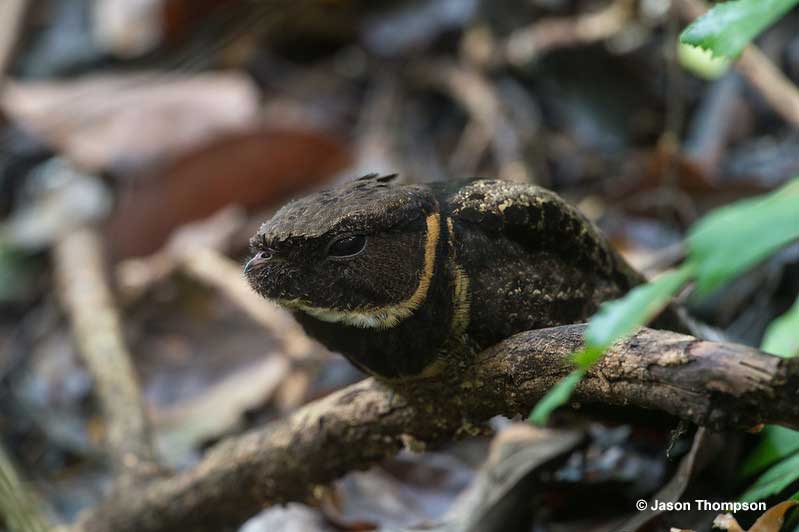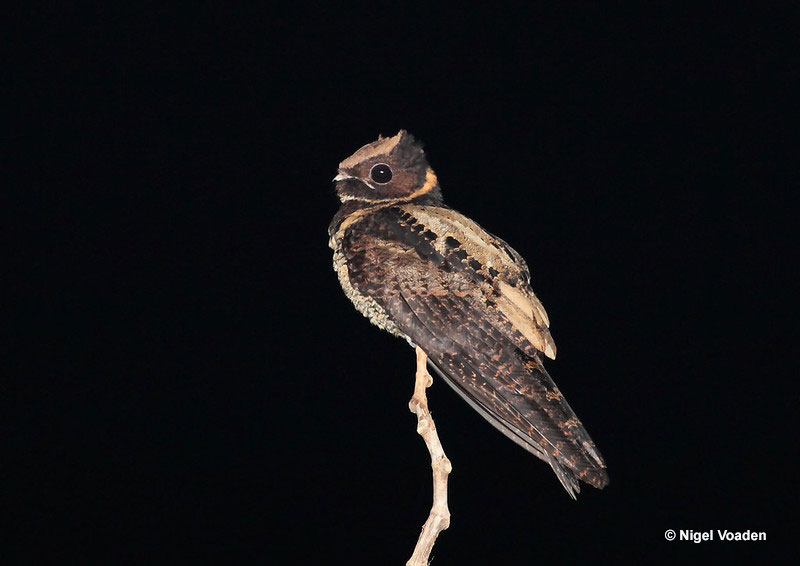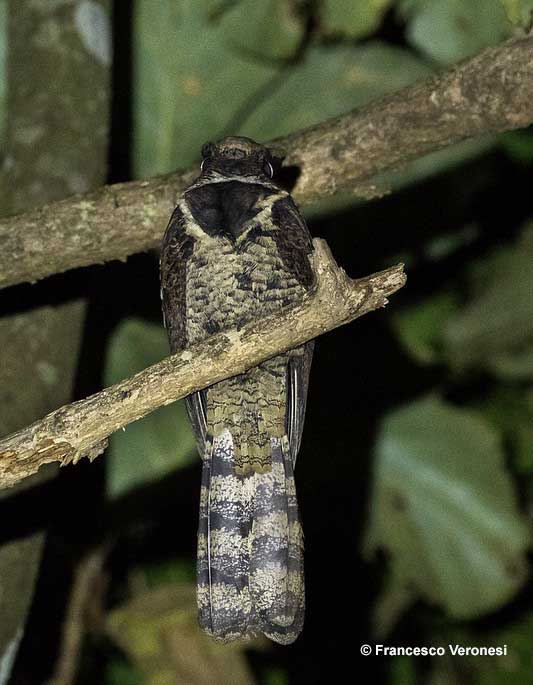Meet the Great-eared Nightjar (Lyncornis macrotis), an elusive nightjar species with big void-like eyes and a dragon-like appearance.
They have a cryptic, camouflaging plumage in various shades of brown and long ear tufts that give them their distinctive look. You cannot find them in North America, though, only in Southeast and South Asia, so you can make your acquaintance with them by reading this article.
On this page
Identification
Great-eared Nightjars are plump, medium-sized birds measuring between 12 to 16 inches long. They have a long tail and slender wings, with their wingspan being around 28 inches.
On average, female Great-eared Nightjars weigh more than males. The birds have dark and tiny bills, but don’t let it fool you, their mouth opens into a wide, gaping hole. You can distinguish them from other similar species by their erect posture and distinct “ears.”
Female and male Great-eared Nightjars share the same appearance. They have cryptic and mottled plumage consisting of shades of brown, black, chestnut, white, gray, and gold.
Their face, back, and breast are dark, and the top of their head, wings, and underside are paler and buffer, with some darker areas and barring. They have a white necklace and banded tails and wings.
Vocalizations
Great-eared Nightjar’s calls are two-parted and have a distinctive, eerie, and haunting quality to them. The first part of the call is a sharp tsiik sound.
This sound is short and crisp, serving as an attention-grabbing element. Then, there is a short pause, followed by a more melodious, whistling ba-haawww. The whistle sounds like something a human might produce.
Keep in mind, that you can only hear them at night since this is a nocturnal species.
Food
Great-eared Nightjars are masters of nocturnal foraging. With their primarily insectivorous diet, they take flight at dusk and nightfall, actively seeking flying insects as their main source of sustenance.
Their long and broad wings give them great maneuverability, which helps them fly low, slow, and silently. They even drink on the fly, gracefully gliding over waterbodies and scooping up water from the surface.
Nesting and Eggs
Great-eared Nightjars typically nest on the forest floor, well-concealed among leaf litter, fallen twigs, and other debris.
Unlike many bird species that construct elaborate nests, these nightjars do not build nests in the traditional sense. Instead, they rely on the natural substrate of the forest floor as their nesting site.
The female will create a simple scrape or depression in the ground by shuffling and clearing away some of the leaf litter and debris. This minimalistic approach to nest construction helps maintain their cryptic appearance.
Great-eared Nightjar’s eggs are buffy with darker blotches. The female lays and incubates only one at a time and the process lasts up to four weeks. During the day, incubation duties fall on the female.
However, at nighttime, the male takes over, and the female leaves to hunt for food. Great-eared Nightjar chicks are covered in dull brown down feathers with more intricate patterns forming as they get older. This helps them blend well into their surroundings.
Current Situation
Great-eared Nightjars range throughout South and Southeast Asia and Southwest India. Their preferred habitat type is subtropical or tropical moist lowland forest, but you can also find them at forest edges and in subtropical or tropical dry shrublands and grasslands with dense vegetation.
Great-eared Nightjars are listed as of least concern on the IUCN Red List, even though the exact population is unknown. They are vulnerable to human disturbance and habitat loss. Further research is still being conducted about this species, including its behavior and exact numbers.
Facts
- The Great-eared Nightjar has big round black eyes, like little voids. What’s truly remarkable is that these eyes come equipped with a built-in ‘night vision’ feature. Behind each of those big peepers, there’s a specialized layer of tissue called a tapetum lucidum. This layer reflects visible light back through their retina, giving them the ability to see in the dark.
- Great-eared Nightjars hold the title for being the largest in terms of length among all nightjar species. However, when it comes to weight, they have to concede the crown to their close relative, the Nacunda Nightjar, making them the second heaviest.
- We don’t know the exact life expectancy of the Great-eared Nightjar, but based on similar species one can assume they may live up to 12 years old.
- Great-Eared Nightjars are often called ‘dragon birds’ for their looks. They’ve become quite a phenomenon, and honestly, they do look really similar to dragons.
Similar Species
Great-eared Nightjars generally look similar to most other nightjar species, with the key differences residing in their upright posture, long ear tufts, and dragon-like face. We have introduced only one similar species within the same range, since appearance-wise, this is the only one that may offer a challenge.
Malaysian Eared Nightjar

Image credit: singaporebirds.com
Malaysian Eared Nightjars also inhabit subtropical and tropical lowland forests. Their range overlaps with the Great-eared Nightjar’s range in northern Malaysia. Appearance-wise, the two species are quite similar, but the Malaysian one is darker overall, has shorter ear tufts, and has a less contrasting crown. Listen for its quite high-pitched whistle that sounds like wit-peew-ow.
Frequently Asked Questions
Why does the Great-eared Nightjar look like a dragon?
The Great-eared Nightjar looks like a dragon because of its horn- or ear-like ear tufts and flat head.
Where is the Great-eared Nightjar found?
The Great-eared Nightjar can be found in Southeast and South Asia, including Southwest India.
Are Great-eared Nightjars rare?
Great-eared Nightjars are not a common sight since they’re elusive and nocturnal creatures. More research is needed regarding their status.
Are nightjars related to owls?
Nightjars are not related to owls. They’re more closely related to hummingbirds and swifts!
Are there nightjars in the USA?
There are six nightjar species in the US. That includes Buff-collared Nightjar, Chuck-will’s-widow, Eastern Whip-poor-will, Mexican Whip-poor-will, Common Poorwill, and Common Nighthawk.



